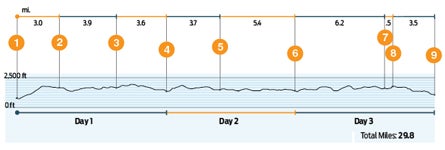Heading out the door? Read this article on the new Outside+ app available now on iOS devices for members! Download the app.
Do it
Skirt the soaring, 1,000-foot walls of the “Grand Canyon of the East” as you meander the western lip of Pine Creek Gorge, the state’s sprawling natural wonder. Take three days to complete this mostly level, 29.8-mile shuttle hike on the only route above the canyon. From the parking lot at Rattlesnake Rocks (1), follow the West Rim Trail’s orange blazes into a thick canopy of hemlock, maple, and oak. Climb 950 feet in two miles (your only major hump), past gurgling Lloyd Run (stop for some photos; “Key Skill,” next page), to the top of the Allegheny Plateau. Pause at a gap in the trees at mile 3 (2) to view the wooded peak of 1,800-foot Gillespie Point, known as “the Matterhorn of the Alleghenies” for its pyramid shape. Spend the rest of the day slipping through patches of ferns as you hike past a series of small campsites spread over the day’s remaining 7.5 miles. Tank up at Steel Hollow Run (3), the last reliable water source on your way to the best site (4), which boasts a balcony view of Pine Creek making an S-turn below. Next day, march 3.7 miles west as the trail rings a private hunting camp. At the Bradley Wales Picnic Area at mile 14.2 (5), find pit toilets and potable water. Follow the gravel road .1 mile to where the trail veers north to a series of bird’s-eye vistas of the canyon; look for boaters and peregrine falcons below. After 5.3 miles, turn left at the blue-blazed Sieman Trail (6) and head .3 mile to a small, flat campsite. Day three, resume heading north on the WRT, following it 6.2 miles as it turns away from the canyon into a forest of maples, red oaks, and white peeling birch. After a sign to Colton State Park at mile 25.8 (7), the trail moves back to the canyon edge (8). For a mile, enjoy a series of rocky overlooks of the gorge snaking southward, cutting a gash into the forests and farmland that border the canyon. Finish by descending 675 feet over two miles through the woods to the trail’s northern terminus off Colton Road (9).
Trip Planner
Shuttle car: From Wellsboro, take US 6 W 11 miles to a left on Colton Rd. Park in .5 mile.
Trailhead: From Wellsboro, go 12 miles on PA 287 S to PA 414 W 7.7 miles to Rattlesnake Rocks.

Gear up & shuttle Pine Creek Outfitters, 5142 Route 6, Wellsboro, PA; (570) 724-3003; pinecrk.com
Contact (570) 724-2868; dcnr.state.pa.us
Trip databackpacker.com/hikes/1438779
KEY SKILL: Nab the perfect creek photo
Avoid overexposed or blurry images and score a creative, frame-worthy pic of this route’s tumbling brooks.
Plan for perfection.
»Time it. If it’s sunny, wait for a cloud so spots of light filtering through the leaves don’t interfere with your exposure. Better yet: Shoot early in the morning, late in the afternoon, or on overcast days. Also, avoid wind; it’ll create unwanted leaf blur.
» Add flair. Use props—feet, a water bottle—to provide a sense of scale and personality. Balance the shot by placing them off-center.
Use a slow shutter speed. Exposing the photo for longer will produce water that looks silky, instead of stopping the flow in action. Start with 1/15 of a second and add time until the water looks smooth. Shrink the aperture as you slow shutter speed to get the exposure you want. Consider a neutral-density filter, which acts like sunglasses for your lens.
Use a tripod. With a slow shutter speed, even your breathing or body’s natural vibrations will turn your pics blurry; your camera needs to remain perfectly still. We like the bargain Manfrotto Compact Series ($67, 2 lbs. 9 oz., manfrotto.com).
SEE THIS: Ruffed Grouse
The Pennsylvania state bird lives year-round in Tioga State Forest’s 160,000 acres, but you’re more likely to hear one than see one. When taking flight, the birds sound like a miniature helicopter bursting into the air—and they often do so within 10 feet of the trail. Territorial males also “drum” the air with their wings, creating a distinctive thumping sound to woo their mates (especially in spring). The birds stand 18 inches high, including a small plume of brown feathers rising from the top of their heads. Look (or listen) for them in the bushes along the entire WRT.
LOCALS KNOW
Humans aren’t alone in their salt habit. “Porcupines have a strong seasonal craving for sodium,” explains Tom Hardisky, a biologist with the PA Game Commission. One favorite source: your car’s tires and hoses (rubber and many plastics contain some sodium as part of the manufacturing process). If a rodent gnashes its teeth into your car’s vitals, you could find yourself stranded, unable to drive to your post-hike beer. According to Hardisky, the salt drive peaks in May and June, with a minor resurgence in late summer, corresponding to hormonal changes in females. Protect yourself by placing moth balls around your car (about every two feet) before your hike (Hardisky says this keeps the animals from detecting the sodium).